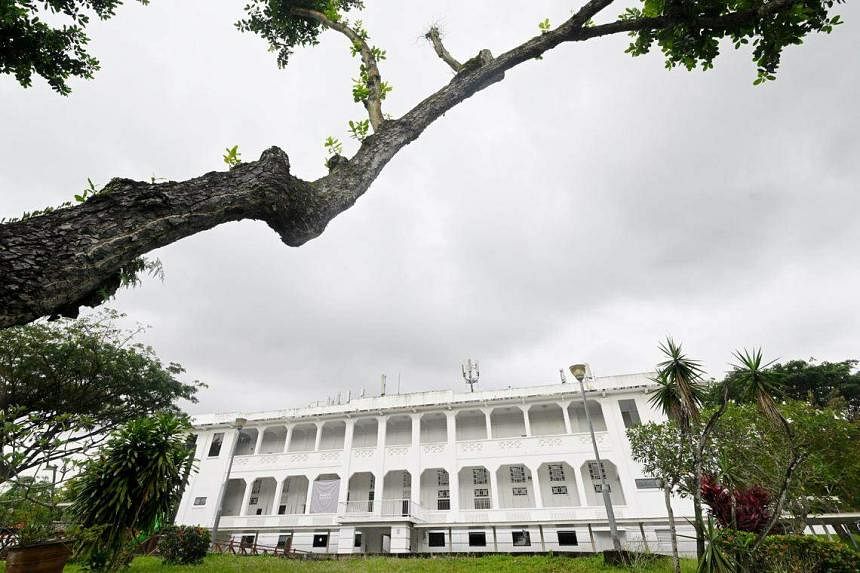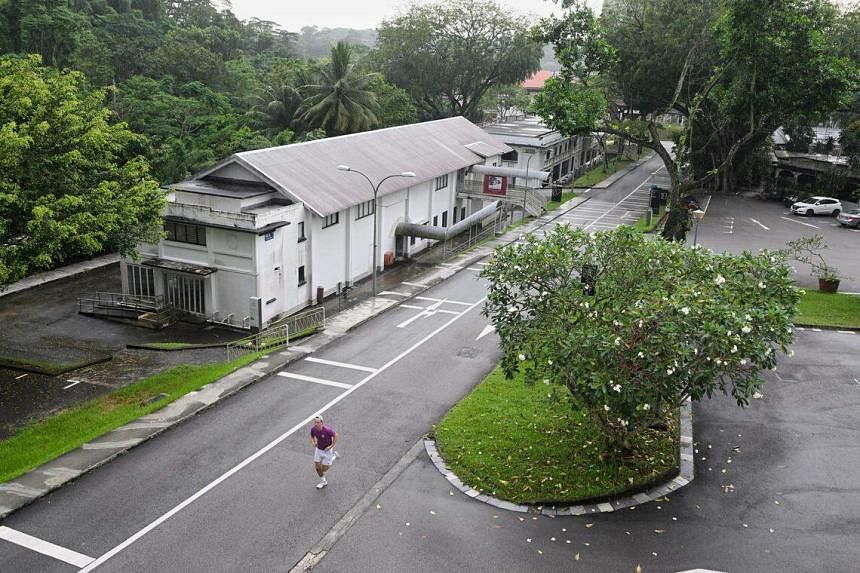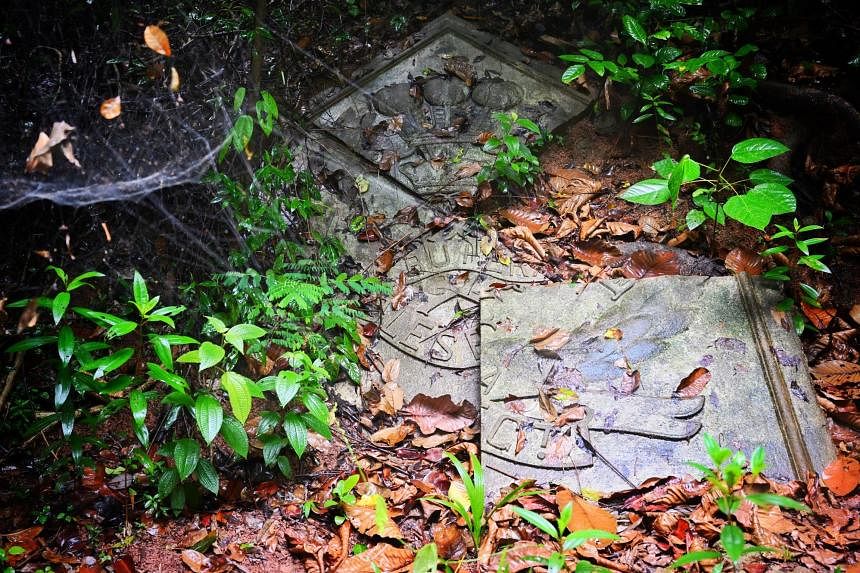SINGAPORE – Hidden in a secondary forest near Gillman Barracks’ remaining buildings are two large concrete insignia of the infantry battalions that the former British military camp housed.
The insignia of the Middlesex Regiment and the Loyal Regiment – surrounded by vegetation for decades and oft-forgotten – are among the little-known features in the area that heritage advocates hope will be surveyed as part of an upcoming heritage study on Gillman Barracks.
On March 5, National Development Minister Desmond Lee announced that the Government is studying plans to develop Gillman Barracks into a new residential neighbourhood with public and private housing.
Before development plans are drawn up, heritage and environmental studies that will inform any future development are slated to start in the second quarter of 2024 and be completed in the first half of 2026.
The concrete insignia, each made up of four square panels that are about 1.2m wide, lie within a roughly 10ha forest patch that nature experts said potentially has great ecological value for the area now and in the future, if left undeveloped.
While the insignia of the Middlesex Regiment – its 1st Battalion was the barracks’ first occupants – remains largely intact and legible, the condition of the Loyal Regiment’s insignia is harder to ascertain.
Only one of its panels was face-up, while the others – assumed to be the remaining pieces of the insignia – were overturned next to it when The Straits Times visited the site on March 8.
Historian John Kwok told ST that Gillman Barracks was where the 2nd Battalion, Loyal Regiment, held out during World War II until the British surrender, after the regiment was unable to resist oncoming Japanese troops who were fighting their way down Alexandra Road, towards the junction where it meets present-day Telok Blangah Road.
“The area’s terrain has not been significantly impacted and altered by development since World War II, so it is still possible to examine and retrace the battle fought along Alexandra Road,” said Dr Kwok.
He said that given the site’s storied past, the upcoming heritage study provides an opportunity to unpack the layers of Gillman Barracks’ history, including the social memories formed over the site’s life – first as a British military camp from 1936, as Singapore Armed Forces (SAF) grounds from August 1971 to the early 1990s, and subsequently as a lifestyle and arts enclave.
After the British handed over Gillman Barracks to Singapore in 1971, the site became the first home of the Singapore Army’s combat engineers till 1984. Dr Kwok said the wide ditch between Alexandra Road and the barracks was used for bridge building training by the engineers, who could train safely yet realistically at an area right next to their camp.
“The site is well-known, and unknown at the same time,” said Dr Kwok. “It is a site of many memories, and I hope that there will be enough lead time for the necessary heritage studies and archaeological surveys before further development planning takes place.”
He suggested that as part of studies, any remaining military features “hidden” in vegetated areas such as the concrete military insignia can be picked up with a Light Detection and Ranging (Lidar) scan that can penetrate the vegetation and pick up any remaining man-made features that surveyors may wish to further investigate.
Mr Ho Weng Hin, founding chair of non-profit heritage group Docomomo Singapore, said Gillman Barracks’ grounds have significantly reduced in size since it was a British military camp.
Any further demolition of its structures would mean the area “no longer has a critical mass of buildings to retain its identity”, he added.
The entire British camp was once about 47ha wide and included grounds currently occupied by The Interlace condominium and other developments along Depot Road, as well as the 10ha forest patch the military insignia were found in.
Mr Ho said 11 of the 17 buildings that are part of Gillman Barracks today were from the colonial era, with others added in later years.
The architectural conservationist said that instead of prioritising only outstanding structures for potential retention, the heritage study – which will fall under the Urban Redevelopment Authority’s heritage impact assessment framework – should be more holistic and assess the buildings as a group, as this better reflects the value that they have collectively accrued over time.
Retaining multiple buildings in a future neighbourhood will “allow relations between them to be explained, experienced and appreciated” by future users of the site, he said, adding that urban design guidelines for new developments will have to be used to protect key vistas and view corridors that give the area its character.
Dr Kwok said that while it is unlikely that all the structures will be retained, a cluster that evokes the most social memories should be kept. These could include Blocks 6, 7 and 9 in Lock Road, he said.
Block 9, for instance, housed the British Navy, Army and Air Force institutes, and was where servicemen could socialise and buy goods from their home country. The block was later used as an officers’ mess during the site’s SAF days, he said.

Military heritage advocate Lukas Ming Menkhoff said Block 9 represents a distinct typology common in 1930s-built military buildings in British Malaya.
He added that although there are other buildings with similar architectural features in Singapore, Block 9 is the only remaining specimen with its specifications, making it unique.
Block 7 bears two logos with the letters “AKC”, which stand for Army Kinema Corporation. According to an information panel in front of the block put up by the authorities, AKC Far East, headquartered in Singapore, was formed in 1946 to provide army film training and affordable entertainment for troops in the region.

Meanwhile, Dr Kwok said Block 6 was the former headquarters of the Singapore Combat Engineers during the SAF days.
Mr Menkhoff said that the potential loss or reduction in size of Gillman Barracks is “greatly concerning”, given the steady loss of other pre-independence military sites such as KD Malaya, as well as Roberts, Nee Soon and Selarang barracks.
“Given Singapore’s relatively short modern history since 1819, government, military and Public Works Department infrastructure are among the oldest and most significant structures built between the 1820s to the 1960s,” he said.
“Although often misunderstood or overlooked, the pre-independence buildings that have escaped redevelopment allow us to tangibly connect with our bygone past.” he said. “It is thus vital that we safeguard these landscapes and architectural treasures, which are critically diminishing more than ever.”
Mr Ho, the founding partner of architectural conservation consultancy Studio Lapis, said the upcoming heritage study is an opportune moment for the history of other sites in the area to be investigated, such as the former St Andrews Junior College and Pasir Panjang Vocational Institute campuses, which both officially opened in the 1970s.
Also of interest, he said, is the campus of Alexandra School in Preston Road, which was opened in 1939 and is today occupied by ISS International School. The original school was attended by children of military families, and in 1964 became the Bourne School that operated until the British military withdrawal in 1971.
Gillman Barracks was one of 19 areas under study in the Heritage and Identity Structure Plan – one of the products of the long-term plan review by the Urban Redevelopment Authority (URA), which was completed in 2022 and will guide Singapore’s development for the next 50 years and beyond.
Mr Ho noted that many of these sites – such as Paya Lebar Air Base and Sembawang Shipyard – have a large land take as well as intact clusters of buildings.
It will be important for the authorities to carry out in-depth studies that ensure the core identity, setting and heritage significance of these areas are retained in the event of future redevelopment, he said.
Botanist Shawn Lum, a senior lecturer at Nanyang Technological University’s Asian School of the Environment, suggested that the environmental study for Gillman Barracks take into account the findings from the survey of the former Keppel Club site, Labrador park and nature reserve, and the Southern Ridges, as well as Alexandra Woodlands and stretches of the Rail Corridor.
The former president of Nature Society (Singapore) noted that while the presence of Albizia trees throughout the forest patch at Gillman Barracks strongly suggests the vegetation is of a relatively young age, the site is nonetheless ecologically valuable as it is large enough to support a variety of animal species, including resident and migratory birds.
He added that environmental consultants should study how the patch facilitates wildlife movement between green patches in the area, especially for species not included in the National Parks Board’s recent Ecological Profiling Exercise.
The exercise mapped vegetated plots in Singapore that act as “highways” for wildlife using six indicator species, including the Sunda pangolin and hill myna.
It will be useful to look not just at the vegetated site’s current value, but also its potential, he added.
“Vegetated areas mature, add species, take on structural complexity, and can deliver a greater range and level of ecosystem services,” he said.
“Assessing the value of the young forest by what is present now would be like assessing the contributions to society of a Primary 1 pupil. The contributions might be years away, but that is the promise of a young person – or in this case, an ecosystem.”


